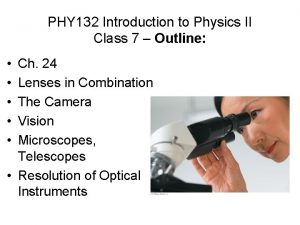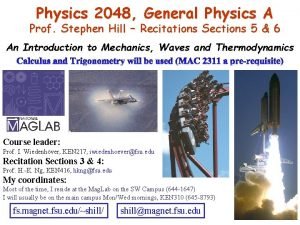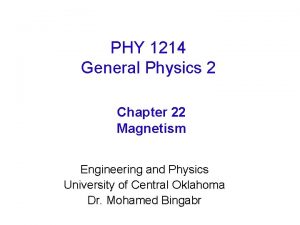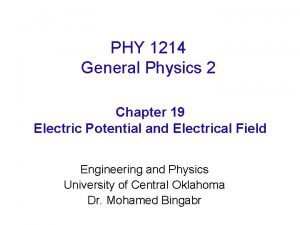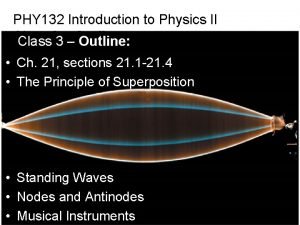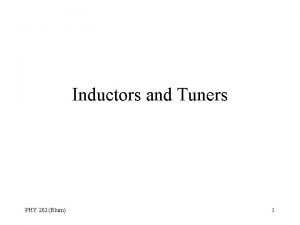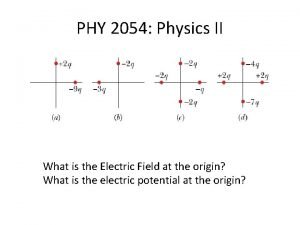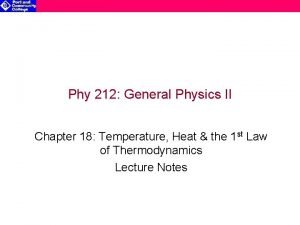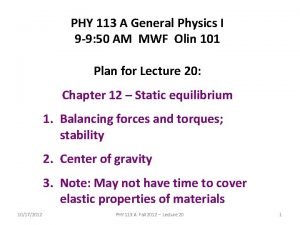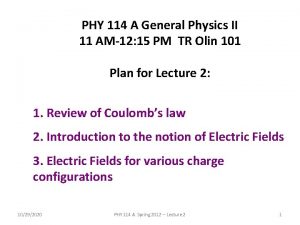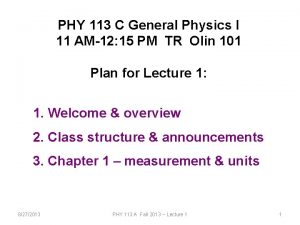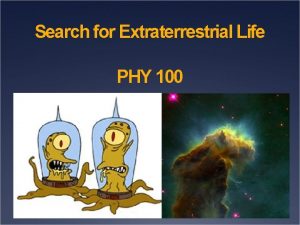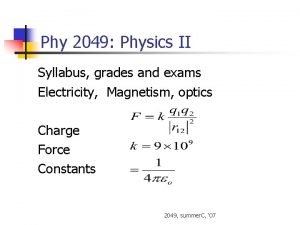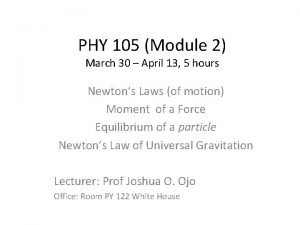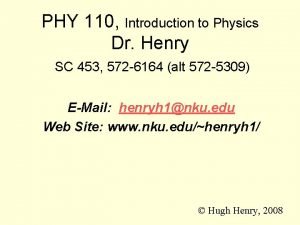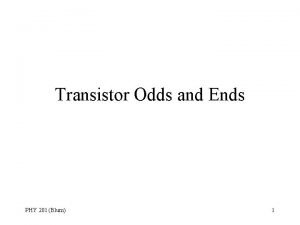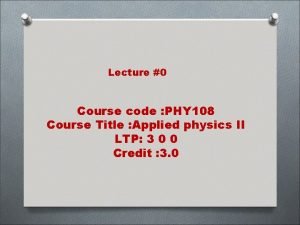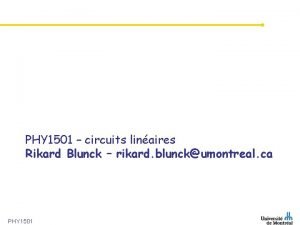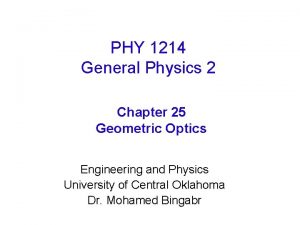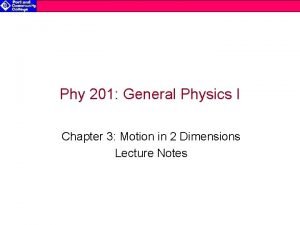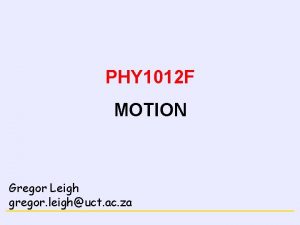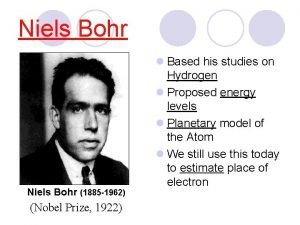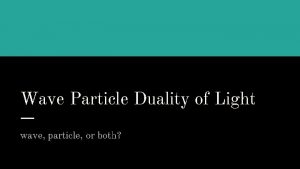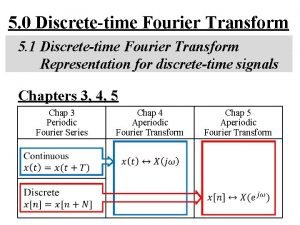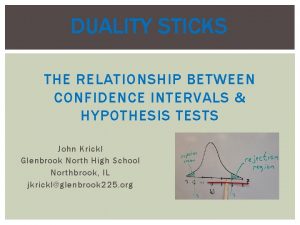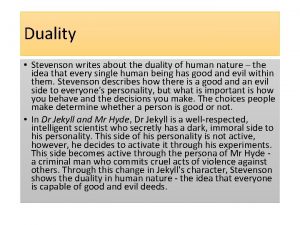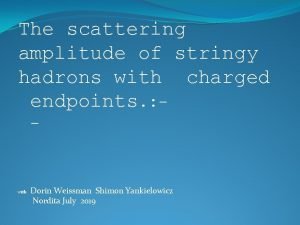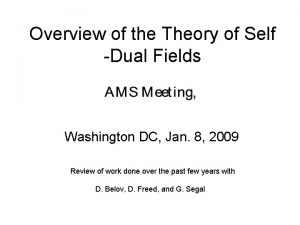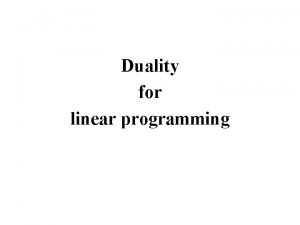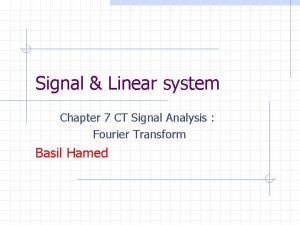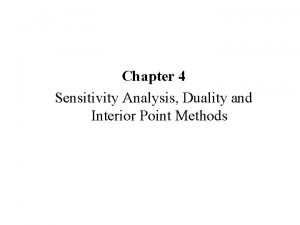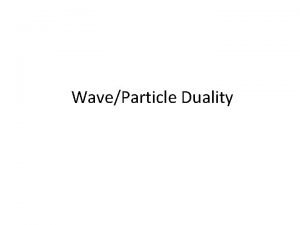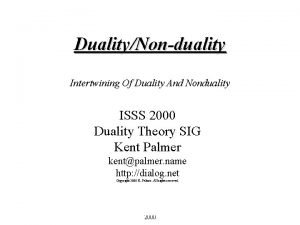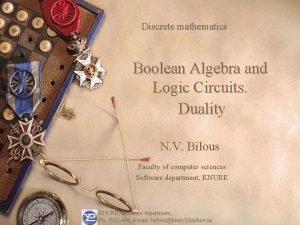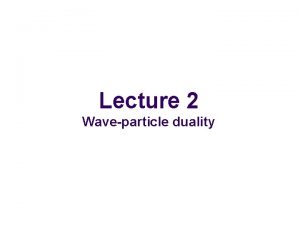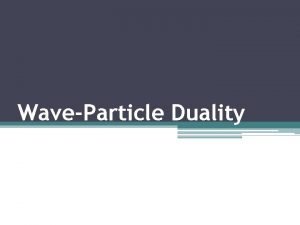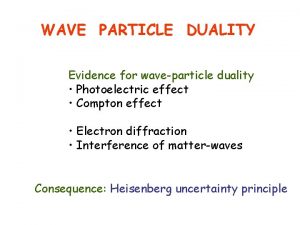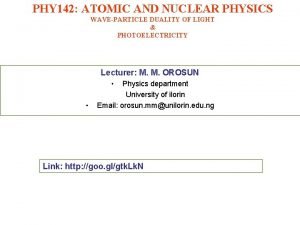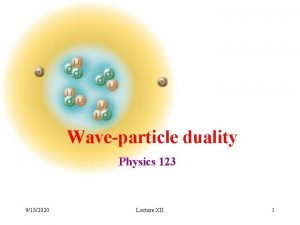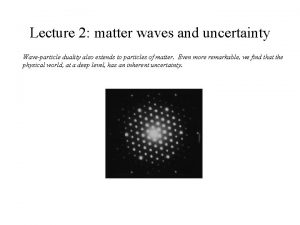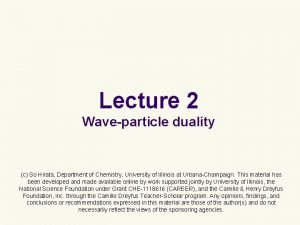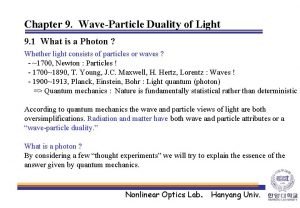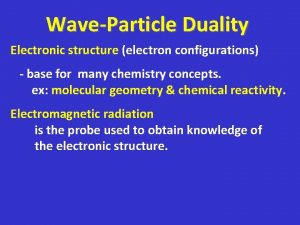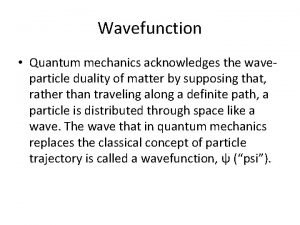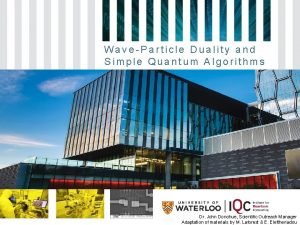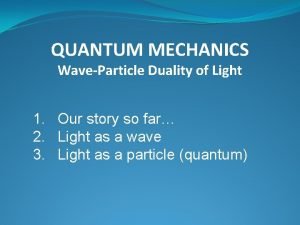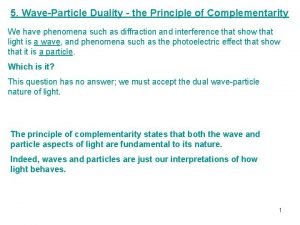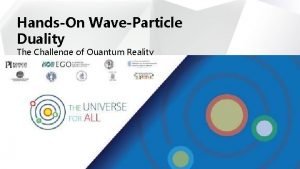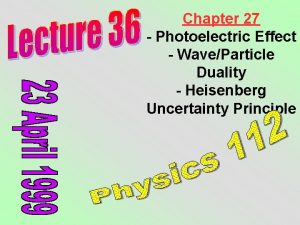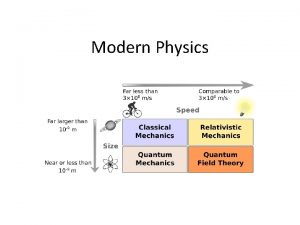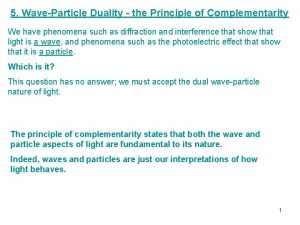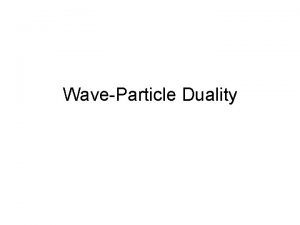PHY 102 Lecture 13 13 1 WaveParticle Duality





























































- Slides: 61

PHY 102: Lecture 13 • 13. 1 Wave-Particle Duality • 13. 2 Blackbody Radiation Planck’s Constant • 13. 3 Photons and Photoelectric Effect • 13. 4 Photon Momentum Compton Effect • 13. 5 de Broglie Wavelength Wave Nature of Matter • 13. 6 Heisenberg Uncertainty Principle

PHY 102: Lecture 12 Particles and Waves 12. 1 Wave-Particle Duality

Wave Interference • Ability to exhibit interference effects is an essential characteristic of waves • An example is Young’s experiment • Light passes through two closely spaced slits and produces a pattern of bright and dark fringes on a screen • The fringe pattern is a direct indication that interference is occurring between light waves coming from each slit

Particle Interference - 1 • 20 th century discovery • Particles behave like waves and exhibit interference • Diagram shows a version of Young’s experiment • Beam of electrons are directed onto a double slit • Screen glows when an electron strikes it

Particle Interference - 2 • (a) • The pattern that would be seen on the screen if each electron behaved like a particle • Each electron were to pass through one slit or the other and strike screen • Pattern would consist of an image of each slit

Particle Interference - 3 • (b) • Shows the pattern actually observed • Consists of bright and dark fringes • Fringe pattern indicates that the electrons are exhibiting interference effects associated with waves

Wave-Particle Duality • The concept of an electron as a tiny discrete particle of matter does not account for the fact that the electron can behave as a wave in some circumstances • The electron exhibits a dual nature, with both particle-like characteristics and wavelike characteristics • Waves can exhibit particle-like characteristics, and particles can exhibit wave-like characteristics

PHY 102: Lecture 12 Particles and Waves 12. 2 Blackbody Radiation; Planck’s Constant

Thermal Radiation - 1 • All bodies continuously radiate electromagnetic waves (blackbody radiation) • We see the glow of very hot objects because they emit electromagnetic waves in the visible region of the spectrum • At low temperatures objects emit visible light waves only weakly and do not appear to be glowing

Thermal Radiation - 2 • At a given temperature, the intensities of the electromagnetic waves emitted by an object vary by wavelength • The two curves show that at a higher temperature the maximum emitted intensity per unit wavelength increases • Also shifts to shorter wavelengths

Max Planck (1858 – 1947) • • 1900 German Explained thermal radiation curves Took first step toward understanding of the wave-particle duality

Planck’s Explanation • • Use a model Blackbody is a large number of atomic oscillators Each emits and absorbs electromagnetic waves Assumed that the energy E of an atomic oscillator could have only discrete values • E = 0, hf, 2 hf, 3 hf, … • E = nhf n = 0, 1, 2, 3, … • f is the frequency of vibration

Planck’s Constant • h is Planck’s constant • h = 6. 62606876 x 10 -34 Js

Quantized Energy • Radical feature of Planck’s assumption • Energy of an atomic oscillator could have only discrete values • hf, 2 hf, 3 hf, … • Energies in between these values are forbidden • Whenever the energy of a system can have only certain definite values and nothing in between the energy is quantized

Quantized Electromagnetic Energy • Conservation of energy requires that the energy carried off by the radiated electromagnetic waves must equal the energy lost by the atomic oscillators • For example, an oscillator with an energy of 3 hf emits an electromagnetic wave • Next smallest allowed value for the energy of the oscillator is 2 hf • Energy carried off by the electromagnetic wave would have the value of hf

PHY 102: Lecture 12 Particles and Waves 12. 3 Photons and Photoelectric Effect

Photons • Electromagnetic waves are composed of particle-like entities called photons • Energy = E = hf • Momentum = p = h/l

Photoelectric Effect - 1 • Experimental evidence that light consists of photons comes from the photoelectric effect • Electrons are emitted from a metal surface when light shines on it • Electrons are emitted if the light has a sufficiently high frequency

Photoelectric Effect - 2 • Ejected electrons move toward a positive electrode called the collector • This causes a current to register on the ammeter • The electrons are ejected with the aid of light • They are called photoelectrons

Photoelectric Effect - 3 • In 1905 Einstein presented an explanation of the photoelectric • Einstein proposed that light of frequency f could be regarded as a collection of discrete packets of energy (photons) • Each packet containing an amount of energy given by • E = hf • h is Planck’s constant

Photoelectric Effect - 4 • Einstein explained that when light shines on a metal, a photon can give up its energy to an electron in the metal • If the photon has enough energy to do the work of removing the electron from the metal, the electron can be ejected • Work required depends on how strongly the electron is held • For least strongly held electrons, the work has a minimum value W 0, called work function

Photoelectric Effect - 5 • If a photon has energy in excess of the work needed to remove an electron, the excess appears as kinetic energy of the ejected electron

Photoelectric Effect Equation • Photon energy = Max. KE of ejected electron + Min. work to eject electron • • hf = KEmax + W 0 KEmax = hf – W 0 If KEmax = 0 then hf 0 = W 0 is the work function

Problem 1 - 1 • In converting electrical energy into light energy, a sixty-watt incandescent light bulb operates at about 2. 1% efficiency • Assuming that all the light is green (vacuum wavelength = 5. 55 x 10 -7 m) • Determine the number of photons per second given off by the bulb

Problem 1 - 2 • At an efficiency of 2. 1% the light energy emitted per second by a sixty-watt bulb is • (0. 021)(60. 0 J/s) = 1. 3 J/s • The energy of a single photon is • E = hf = hc/l • E = (6. 63 x 10 -34)(3. 00 x 108)/5. 55 x 10 -7 • E = 3. 58 x 10 -19 J • Photons / sec = 1. 3/3. 58 x 10 -19 =3. 6 x 1018

Problem 2 - 1 • Work function for silver surface is W 0 = 4. 73 e. V • Find the minimum frequency that light must have to eject electrons from this surface üW 0 = (4. 73 e. V)(1. 60 x 10 -19 J/1 ev) üW 0 = 3. 58 x 10 -19 J ühf 0 = KEmax +W 0 = 0 + W 0 üf 0 = W 0/h = 7. 57 x 10 -19 J/6. 63 x 10 -34 Js üf 0 = 1. 14 x 1015 Hz ül 0 = 263 nm ultraviolet

Classical vs Modern Physics - 1 • Classical Physics • Kinetic energy of electron independent of frequency • Modern Physics • Only light with a frequency above a minimum value will eject electrons • Regardless of brightness of light

Classical vs Modern Physics - 2 • Classical Physics • Maximum kinetic energy of electron increases as brightness of light increases • Modern Physics • Maximum kinetic energy remains the same as the brightness increases • As brightness increases, the number of electrons ejected increases

Classical vs Modern Physics - 3 • Classical Physics • For a dim beam of light, there should be a long delay before electrons are emitted • Modern Physics • Electrons are emitted immediately

PHY 102: Lecture 12 Particles and Waves 12. 4 Photon Momentum / Compton Effect

Arthur H. Compton (1892 – 1962) • • 1923 American Physicist Used photon model to explain scattering of X-rays by the electrons in graphite • X-rays are high-frequency electromagnetic waves and are composed of photons

Compton Effect - 1 • X-ray photon strikes an electron in graphite • The X-ray photon scatters in one direction after the collision • Electron recoils in another direction

Compton Effect - 2 • • Scattered photon has frequency f’ Smaller than the frequency f of incident photon Photon loses energy during collision Difference between two frequencies depends on angle q at which the scattered photon leaves the collision

Compton Effect Conservation of Energy / Momentum • Energy of incident photon = Energy of scattered photon + Kinetic energy of recoil electron • hf = hf’ + KE • hf’ = hf – KE • Energy and frequency of scattered photon is less than energy and frequency of incident photon • Momentum of incident photon = Momentum of scattered photon + Momentum of recoil electron

Compton Effect Equation • • l’ – l =(h/mc)(1 – cosq) m is mass of electron h/mc is the Compton wavelength of electron h/mc = 2. 43 x 10 -12 m

PHY 102: Lecture 12 Particles and Waves 12. 5 de Broglie Wavelength / Wave Nature of Light

Louis de Broglie (1892 – 1987) • 1923 • French • Suggested that since light waves could exhibit particle-like behavior, particles of matter should exhibit wave-like behavior • de Broglie wavelength • l = h/p – h is Planck’s constant – p is magnitude of relativistic momentum of the particle

Clinton J. Davisson (1881 – 1958) Lester H. Germer (1896 - 1971 • 1927 • American • Directed a beam of electrons on a crystal of nickel • Observed that the electrons exhibited a diffraction behavior

Neutron Diffraction Pattern

Problem 3 - 1 • Determine the de Broglie wavelength for • (a) an electron (mass = 9. 1 x 10 -31 kg) moving at a speed of 6. 0 x 106 m/s • (b) a baseball (mass = 0. 15 kg) moving at a speed of 13 m/s

Problem 3 - 2 • Determine the de Broglie wavelength for • (a) an electron (mass = 9. 1 x 10 -31 kg) moving at a speed of 6. 0 x 106 m/s • momentum = p • p=mv = 9. 1 x 10 -31 x 6 x 106 = 5. 46 x 10 -24 • l = h/p = 6. 63 x 10 -34 / 5. 46 x 10 -24 • l = 1. 21 x 10 -10 m

Problem 3 - 3 • Determine the de Broglie wavelength for • (b) a baseball (mass = 0. 15 kg) moving at a speed of 13 m/s • momentum = p • p = mv = 0. 15 x 13 = 1. 95 • l = h/p = 6. 63 x 10 -34 / 1. 95 • l = 3. 4 x 10 -34 m

What Kind of Wave is de Broglie Wave? -1 • (a) Shows the fringe pattern on the screen when electrons are used in a version of Young’s double-slit experiment • Bright fringes occur in places where particle waves coming from each slit interfere constructively • Dark fringes occur in places where the waves interfere destructively

What Kind of Wave is de Broglie Wave? -2 • When an electron passes through the double-slit arrangement and strikes a spot on the screen glows at that spot • (b), (c), (d) • Illustrate how the spots accumulate in times • As more and more electrons strike the screen, the spots eventually form the fringe pattern

What Kind of Wave is de Broglie Wave? -3 • Bright fringes occur where there is a big probability of electrons striking the screen • Dark fringes occur where there is a low probability • Particle waves are waves of probability • Magnitude at a point in space gives an indication of the probability that the particle will be found at that point

What Kind of Wave is de Broglie Wave? -4 • At the place where the screen is located, the pattern of probabilities conveyed by the particle waves causes the fringe pattern to emerge • The pattern of probabilities that leads to the fringes is analogous to the pattern of light intensities that is responsible for the fringes in Young’s experiment with light waves

Wavefunction • In the case of particle waves, the probability is proportional to the square of the magnitude Y • Y is the wave function of the particle • In 1925, Erwin Schrodinger and Werner Heisenberg developed theoretical frameworks for determining the wave function • Established a new branch of physics called quantum mechanics

PHY 102: Lecture 12 Particles and Waves 12. 6 Heisenberg Uncertainty Principle

Uncertainty - 1 • Bright fringes indicate the places where there is a high probability of an electron striking the screen • There a number of bright fringes • There is more than one place where each electron has some probability of hitting • It is not possible to specify in advance exactly where on screen an individual electron will hit • All we can do is speak of probability that electron may end up in a number of different places

Uncertainty - 2 • No longer is it possible to say, as Newton’s laws would suggest, that a single electron, fired through the double slit, will travel directly forward in a straight line and strike the screen • This simple model does not apply when a particle as small as an electron passes through a pair of closely spaced narrow slits • Wave nature of particles is important in such circumstances, we lose the ability to predict with 100% certainty the path that a single particle will follow

Uncertainty - 3 • Consider electrons passing through a single slit • After a sufficient number of electrons strike the screen, a diffraction pattern emerged • Electron diffraction pattern consists of alternating bright and dark fringes • Analogous to light wave diffraction pattern

Uncertainty - 3 • Figure shows the slit and locates the first dark fringe on either side of the central bright image • Central fringe is bright because electrons strike the screen over the entire region between the dark fringes

Uncertainty - 4 • To reach locations within the central bright fringe, some electrons must have acquired momentum in the y direction • Despite the fact that they enter the slit traveling along the x direction and have no momentum in the y direction to start with

Uncertainty - 5 • y component of momentum may be big as Dpy • The notation Dpy indicates the difference between the maximum value of the y component of the momentum after the electron passes through the slit and its value of zero before the electron passes through the slit

Uncertainty - 6 • Dpy represents the uncertainty in the y component of the momentum in that the y component my have any value from zero to Dpy

Uncertainty - 7 • Assume that light diffraction equation also applies to particle whose wavelength is l • sinq = l/W locate first dark fringe • If q is small then sinq tanq • tanq = Dpy/px

Uncertainty - 8 • Dpy / px = Dpy / (h/l) = l/W • Dpy / px = h / W • Heisenberg suggested that the uncertainty Dpy is related to the uncertainty in the y position of the electron as the electron passes through the slit

Uncertainty - 9 • Electron can pass through anywhere within the width W • Dy = W • This leads to (Dpy)(Dy) = h

Heisenberg Uncertainty Principle • Momentum and position • (Dpy)(Dy) >= h/4 p • Dy = uncertainty in a particle’s position along the x direction • Dpy = uncertainty in the y component of the linear momentum of the particle • Energy and Time • (DE)(Dt) >= h/4 p • DE = uncertainty in the energy of a particle when the particle is in a certain state • Dt = time interval during which the particle is in the state

Problem 4 - 1 • Assume that the position of an object is known so precisely that the uncertainty in the position is only Dy = 1. 5 x 10 -11 m • (a) Determine the minimum uncertainty in the momentum of the object • (b) Find the corresponding minimum uncertainty in the speed of the object in the case when the object is an electron (mass = 9. 1 x 10 -31 kg)

Problem 4 - 2 • Assume that the position of an object is known so precisely that the uncertainty in the position is only Dy = 1. 5 x 10 -11 m • (a) Determine the minimum uncertainty in the momentum of the object • Dpy >= h/4 p. Dy = (6. 63 x 10 -34)/4 p(1. 5 x 10 -11) • Dpy >= 3. 5 x 10 -24 • (b) • Dpy >= 3. 5 x 10 -24 = m. Dv • Dv >= 3. 5 x 10 -24 / 9. 1 x 10 -31 = 3. 8 x 106 m/s
 Transopia
Transopia 01:640:244 lecture notes - lecture 15: plat, idah, farad
01:640:244 lecture notes - lecture 15: plat, idah, farad Phy tgen
Phy tgen Phy 131 asu
Phy 131 asu Stephen hill fsu
Stephen hill fsu General physics
General physics Phy 1214
Phy 1214 Phy 2049
Phy 2049 Phy 132
Phy 132 Felix connects a wire coil to an ammeter
Felix connects a wire coil to an ammeter Phy 221 msu
Phy 221 msu Fizik ii
Fizik ii Ddr phy architecture
Ddr phy architecture Phy 212
Phy 212 2012 phy
2012 phy Phy 131 past papers
Phy 131 past papers Phy
Phy Phy
Phy Phy 1214
Phy 1214 Life phy
Life phy Phy theorem
Phy theorem Phy 2049
Phy 2049 Phy-105 5 discussion
Phy-105 5 discussion Phy 205
Phy 205 Phy 1214
Phy 1214 Phy 110
Phy 110 Phy 231 msu
Phy 231 msu Phy
Phy Phy 108
Phy 108 Phy
Phy Phy circuit
Phy circuit Phy 113 past questions and answers
Phy 113 past questions and answers Real image
Real image Site:slidetodoc.com
Site:slidetodoc.com Phy 1214
Phy 1214 Phy
Phy The great orthogonality theorem
The great orthogonality theorem Atm basics
Atm basics Duality concept
Duality concept De broglie
De broglie What is a particle
What is a particle Duality of fourier transform
Duality of fourier transform Duality of confidence interval and hypothesis test
Duality of confidence interval and hypothesis test Jekyll and hyde quotes
Jekyll and hyde quotes Holographic duality theory
Holographic duality theory Duality in frankenstein
Duality in frankenstein Fourier series formulas
Fourier series formulas Discreteness and duality
Discreteness and duality Double articulation
Double articulation Chern simons theory
Chern simons theory What is duality in accounting
What is duality in accounting Customer supplier duality
Customer supplier duality Concept of duality in linear programming
Concept of duality in linear programming Duality of fourier transform
Duality of fourier transform Duality memory locations
Duality memory locations Black-rangarajan duality
Black-rangarajan duality Sensitivity analysis and duality
Sensitivity analysis and duality Arbitrary in linguistics
Arbitrary in linguistics Wave particle duality questions
Wave particle duality questions Non-duality
Non-duality Jekyll and hyde quotes about setting
Jekyll and hyde quotes about setting Law of duality in discrete mathematics
Law of duality in discrete mathematics
